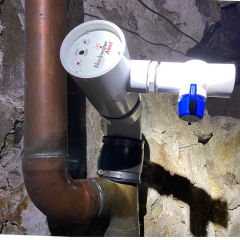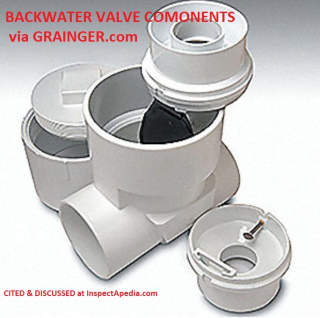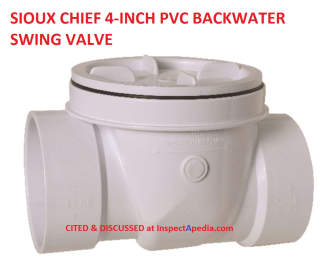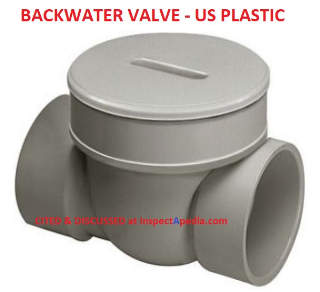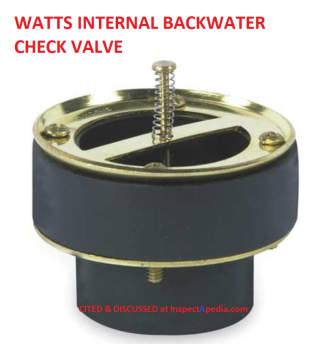 Sewer Backup Prevention
Sewer Backup Prevention
Guide to Backwater Valves & Toilet Plugs
to Prevent Sewer Line Backups into the Building
- POST a QUESTION or COMMENT about backflow preventer valves, sewer backups, toilet drain backup prevention and sewer line backup prevention
Sewer line backup prevention:
This document explains for homes connected to a municipal sewer we discuss how to prevent sewer or storm drain backups into a building during rain or heavy flooding including the installation and use of backflow preventers, backwater valves, check valves and toilet drain plugs.
Here we discuss an example case of a midnight main sewer line backup into a home washing machine. Use of check valves or backwater valves to avoid basement flooding from heavy rain. Main sewer line or drain line check valve installation & inspection, maintenance. Choose or make a plug for toilets that overflow during sewer line backups? Check valves for basement floor drains.
Definition of backwater valve: as used here a backwater valve is a check valve installed on a building drain to prevent backup should the drain line receive floodwaters from outside the building, such as due to area flooding or a septic or sewer line backup.
InspectAPedia tolerates no conflicts of interest. We have no relationship with advertisers, products, or services discussed at this website.
Guide to Use of Backwater Check Valves to Prevent Septic or Sewer Backups Due to Flooding or Sewer Main Backups
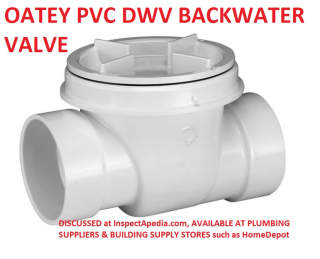 The sewer line back flow prevention valve shown at page top is produced by Mainline Backflow Products - Backwater Valves (image use permission).
The sewer line back flow prevention valve shown at page top is produced by Mainline Backflow Products - Backwater Valves (image use permission).
If toilets are overflowing,
see TOILET OVERFLOW EMERGENCY.
If your building drains are already backing up, especially during a time of heavy use such as with guests in the home,
or for homes connected to municipal sewer, see
CLOGGED DRAIN DIAGNOSIS & REPAIR
If your sewer or septic system uses a sewage pump, be sure to
review SEPTIC PUMPS
and SEWAGE PUMP DAMAGE & REPAIR.
If your home is connected to a private septic system and drains are already backing up, especially during a time of heavy use such as with guests in the home,
see SEPTIC BACKUP REPAIR.
Late Night Sewer Backup Starts Washing Machine in the Basement
One of our clients in Cold Spring New York reported waking during the night to hear their old basement clothes washer running. Having just moved into the home the occupants wondered what ghost was doing laundry at 2 AM. Investigating they found that the local municipal sewer had backed up into the home through the main drain line.
Because their washing machine drain was improperly connected (without an air gap) to a drain line, and as it was the lowest plumbing fixture in the home, the clothes washer had literally filled up with sewage.
Since this old clothes washer included a pressure switch that automatically turned on the washer when it sensed that the tub was filled, the washer had not only received backing up sewage, but had begun agitating it in the middle of the night.
Further investigation showed that sewer backups were notorious in the neighborhood, and that this home lacked a sewage backflow preventer at the home's connection to the sewer line. The home suffered from
- A village sewer line that was prone to backups
- No backwater prevention valve protecting the home
- A cross-connection that improperly connected the clothes washer to the home's drain piping without an air gap.
See CROSS CONNECTIONS, PLUMBING.
Question on basement flooding due to sewer line backup:
I had a sewer backup into my home again yesterday at a basement toilet. Our main line has a sewer back-up flap [a wastewater check valve or backwater valve].
The main sewer line check valve works fine when sewer is full from a very heavy rain in a short time. But yesterday we had 60 cm rain in 30 minutes. I had back-up valves on the sink, vanity, shower,clothes washer (drains).
The only place where backup occurred is the basement toilet. I managed placing a ball of rags into the toilet and applying pressure that stopped the water.
Our backup was actually clean water from a flat roof draining into the sewer venting pipe. This is a duplex home.
Is there such a thing as a soft plastic or other material filled that would take the shape of the toilet and prevent water coming back up as overflow. Like I did with a ball of cloths, and a brick wrapped in plastic. It did the trick in an emergency, but it's not practical. - (Anonymous by request)
Answer:
The advantage of installing a main sewer line backup prevention valve is that this device will avoid having to plug multiple drains in the home, and the valve, basically a big check valve, is always in place - you don't have to do a thing to get it to work.
If you are having plumbing or sewer line drains back up, including at the toilet, then either your main sewer line check valve is not working, or your backup is occurring (as you suspect) because water or wastewater is draining into your in-house building drain/waste/vent system before or ahead of the main sewer drain check valve.
While you could install another check valve at or near the basement toilet waste line, it makes more sense to install just one such valve to protect the entire building and to make sure that one is working properly.
Stuffing a rag or any other temporary "block" into a toilet or other drains is not the best approach to this problem. Not only can it be unsanitary and a health risk in some cases , but also, who is going to stuff drains when flood conditions occur and no one is at home?
See SEWAGE PATHOGENS in SEPTIC SLUDGE
Install a Main Sewer Line Check Valve or Sewer Cutoff Valve or Make Sure Installed Valves are Working
First you may want to have your main waste line backup check valve inspected - if the sewer line is backing up from the street into your home, your main sewer sewer backup valve (waste backwater valve) or a flood guard valve is not working properly it won't protect from flooding from storm drainage or sewage backups.
Here is
a CHECK VALVE MAINTENANCE GUIDE [PDF] from the City of Ann Arbor, MI.
Mainline Backflow Products, a producer of sewer line check valves and related products, informs us that:
Many municipal Building Codes require you to have a backwater valve if your plumbing fixtures are below the top of the first upstream manhole on your street. A properly operating backwater valve allows flow to only go in one direction (out), preventing wastewater from entering your building during regular sewer system maintenance or accidental sewer system backups.
To find out if you have or need a backwater valve, check your plumbing plans or consult with your builder or a professional plumber.
Remember, if sewage backs up into your home, the cost to repair damages and clean up the mess will be well high than the cost to install a valve.
Laws allow that towns and municipalities cannot be held liable for damages when a backwater valve has not been installed by a property owner.
The City of Chicago and folks writing about Chicago sewer backups offer advice about avoiding sewer backups including the use of basement floor drain standpipes:
A stand pipe is a short section of pipe that when screwed into the basement floor drain will prevent water from coming in through the drain.
However, if there is enough pressure in the sewer system, the sewage will rise through the wash machine drain connection, utility sink, and basement bathroom fixtures.
A stand pipe does nothing to relieve the pressure in the sewer system, and can cause the sewer lines to crack or break under the foundations.
When this happens, the sewage will cause cracks in the basement floor, and may come through the basement walls. If there is enough pressure, the basement walls can collapse, or the foundation can "float" out of its hole. In the worst case, the entire house can collapse into the basement.
Because of these dangers, stand pipes and other methods of blocking the drains ARE NOT RECOMMENDED!
Don't Route Roof or Surface Drainage into the Sewer Piping System
Second, you should disconnect your roof drainage from the sewer piping system entirely, routing it to a nearby storm drain, or to the ground surface (at least 12 feet away from the building and to a location that drains away from the building to avoid basement flooding).
If connecting roof runoff drains to the sewer system is actually permitted in your neighborhood, try changing the drain connection to one that is downstream from your main sewer line trap and check valve.
By the way, in some communities it is illegal to rout roof runoff into the sewer piping. Doing so significantly increases the wastewater volume load on the municipal sewer treatment system so severely that during a storm the sewage treatment plant simply overflows, dumping raw sewage into nearby rivers or waterways.
Keep your Drains from Clogging & Unblock Slow or Clogged Drains
A clogged building drain can also lead to a sewage backup or toilet overflow even if the main drain is properly protected from sewer line backups. Flushing needles, diapers, paper products, sanitary products, and grease into drains is always a bad idea.
We discuss some of these items for homes served by private septic systems
at NEVER FLUSH INTO SEPTICS. It's a good idea to keep those same items out of drains connected to a municipal sewer as well.
See CLOGGED DRAIN DIAGNOSIS & REPAIR for details about slow or clogged plumbing drain diagnosis, prevention, and repair.
Other Floor Drain Check Valves to Prevent Basement Floods
In addition, or sometimes instead of a main sewer line check valve, flood guards are often installed in individual floor drains for drains up to 4" in diameter.
But if a main sewer drain check valve is installed and we are not draining roof runoff into the building drain piping, these should not be needed except on floor drains that connect not to the sewer piping but to a separate storm drain system.
Reader Question: Is there a plug for toilets that will prevent sewage backups into my basement?
Quick question, when it rains hard where I live our basement toilet backs up with water. Is there a plug of some sort I can put in it to stop this from happening.
Something like a shower plug but that would work in toilets. Thank you for your time. J.P.
Reply: How to plug or seal off a basement toilet and the building sewer line against sewer backups
A competent onsite inspection by a plumbing expert who is familiar with sewer backups usually finds additional clues that help accurately diagnose a problem such as an improper house drain installation, other sewer backup risk points such as basement floor drains or sinks, even washing machines, or the need for a check valve or backflow preventer valve at your home main drain.
How to plug or seal off a basement toilet against sewer backups - temporary toilet seals are unreliable and risky but here are some suggestions for preventing sewage backing up through a toilet on the building's lowest floor.
How to plug a toilet drain against sewer line backups: toilet drain test plugs
We don't know about a functional plug that fits in a toilet bowl and that reliably seals any toilet bowl shape against sewer backups.
As we describe here, there are however plumbing drain test plugs designed for all sizes of drain piping including ones commonly used to close off a toilet drain opening when no toilet is installed.
And one type of these might work to seal some toilet bowls, depending on the toilet bowl shape and dimensions.
Typically a toilet drain piping itself is 4" in diameter and can sealed easily using a 4" expanding test plug. But sealing the drain inside a toilet bowl against sewer backups is a different matter.
- First the toilet bottom opening is not round, so a plumbing drain test plug may not seal the drain reliably;
- second forcing a plug into the bottom of a toilet risks cracking and ruining the bowl; third,
- using something makeshift (a ball of newspaper or loaf of bread) risks flushing a hard-to-clear blockage down the drain;
- fourth, even if we can plug the basement toilet against sewage backups,
Nylon or metal based expanding plumbing drain test plugs using rubber, silicone, neoprene, nitrile, or vitron flexible seals are devices that employ a screw and compression plate to permit a plug to be inserted and expanded to seal a round drain opening.
Plumbing drain test plugs used for testing plumbing drains for leaks (openings are plugged and the drain system is pressurized) are available from most plumbing suppliers.
But most plumbing drain system test plugs such as Pipestoppers™ won't work nor seal properly in openings that are not round. [4]
Flexible or inflatable pipe plugs may fit some toilets
An exception that might fit some toilet bowls and permit plugging an in-place toilet against occasional sewer backups are inflatable plumbing test plugs such as the Petersen line of inflatable plumbing test plugs and the Test Ball® Inflatable Plumbing Test Plugs produced by Cherne Industries. [5] [6]
Watch out: plugging a basement toilet or toilet drain might stop sewer backups that have been flowing up and out into the building through one or more toilets found on its lowest level.
But if other drain openings are present, the rising pressure from a sewer line backup may simply find the next higher drain opening (bath tub, sink, shower floor, even washing machine). That's why we recommend the alternative sewer backup prevention steps listed
Abandon the basement toilet to prevent sewer line backups into the building?
If your home includes a basement toilet that is a source of sewer backups, and if there are no other low-building drains that will assume that role if the toilet is eliminated, we suggest you consider removing the toilet completely, abandoning its use, and plugging the toilet drain line at floor level.
But if the basement toilet is needed and/or if there are simply other drains that will become the sewage backup and entry points if the toilet is removed, abandoning the toilet doesn't make sense.
How to use backflow prevention valves, backwater valves, or main drain check valves on the building drain protect against sewer backups
That said, our last suggestion is the best solution - a check valve (properly referred to as a backflow prevention valve or in some areas a "backwater valve") can be installed on the main building drain can prevent sewer backups through the toilet when the area sewer lines are flooding.
Install a flood alarm or backflow preventer valve (backwater valve) integrated flood alarm
If your home is subject to frequent risk of flooding or water entry or sewer backups, look into a flood alarm that can be installed along with the backflow preventer valve on your main building drain.
Alarms are available that sense water on the basement floor, indicating the beginning of water entry and provided someone is at home, giving time to investigate and take action.
But when discussing sewage backups through lower floor drains or toilets, we refer you instead to a somewhat different product such as the Rialco™ flood alarm [3] that is integrated into your backflow preventer, informing you when that special check valve has closed against a sewer backup.
By installing a replacement waterproof cap on the backwater valve installed at the main building drain, the modified back-water valve cap permits connection of the Rialco flood alarm sensor tubing to a port that will inform the alarm that the backwater valve has been activated.
Thus the building owner or occupants are informed of sewer line flood conditions as well as of the fact that the valve is working.
Besides backflow preventers, other types of check valves used on building plumbing and heating systems are discussed
at CHECK VALVES, WATER SUPPLY, DRAINS, PUMPS.
Don't confuse a backwater valve with a backflow preventer used on water supply piping and discussed separately
at BACKFLOW PREVENTER on Heating Sys Water Feed.
Reader comment: Kohler Adair toilet and toilet bowl plug to avoid sewer backups
(Aug 13, 2014) Denny Mack said:
In regards to J.P.'s question regarding sticking a plug inside the toilet bowl to prevent an emergency sewer backup, I performed a test. I have a Kohler Adair toilet in my basement.
The hole in the bowl is approximately 3 inches give or take. I inserted a 3 inch Cherne Inflatable test plug three quarters of the way in the hole.
Even though these plugs are not specifically made for this application, I was desperate to try anything to avoid a sewage disaster. Important notes: It took about a half second shot with my compressor to inflate. (A bicycle pump will not work) Know your compressor. You may want to hold the plug in your hand and test inflate before putting it in the bowl. Also, read the test plug instructions regarding PSI.
After inflating, I flushed the toilet to trap some water. I marked the water level, then returned 2 hours later to check it. The water level was unchanged. Even though I have no clue if the inflatable plug stresses the porcelain, if carefully done, it appears to be an effective plug for this model toilet.
Reader Question: cost to install a mainline check valve to prevent sewer backup
25 June 2015 karen holmes said:
How much does it normally cost to put a check valve in..We had one backup of sewer and don't want another
Reply:
Karen
The installed cost for a sewer line check valve (backwater valve) is the sum of parts plus labor and ranges from $1000. to two or more times that depending on just what is required. For a ballpark estimate consider the following cost for an indoor basement floor check valve then read the added details we give just below:
Parts for the sewer line backwater valve and floor access box: $300.
Labor to install an in-floor backwater valve in a basement including concrete removal, excavation, sewer line cut, valve installation, installation of a floor access box, and concrete repair: $750.
Total installed cost for a sewer line check valve cost: $1050. USD.
Plumbing permits and inspections may be required in some jurisdictions as well.
The price of a backwater valve also referred to as a main sewer line check valve or "mainline check valve"ranges between about $150. and $300. USD depending on the backwater valve model and features. Add an additional $70. if an in-floor access box is required for your location.
The labor for installation of a backwater valve is likely to be significantly more than the cost of the valve itself and is typically billed in hours for plumbing service to which an added cost for backhoe and excavation or concrete removal is required in some situations.
Those costs vary depending on where you live but you can figure roughly $100-$350 per day and up to rent a small backhoe, or you can expect to pay $50. to $100. per hour to hire a backhoe operator if outdoor excavation is required to expose your sewer line.
The installation cost for a sewer line check valve varies depending on
- The ease of access to the existing piping. For example if concrete has to be removed or a sewer line requires deep excavation the cost for installation could be considerably over $1000.
- Features required, such as the provision of an access box to give ready access to an in-floor installed back water valve
Backwater Valves, Alarms: Codes, Standards, Sources & Products
Photo: a Backwater Alert alarm system installed at tne cleanout for a building maindrain, courtesy of Backwater Alert, cited below. [Click to enlarge any image]
- Also see the citations at CHECK VALVES, WATER SUPPLY, DRAINS, PUMPS
- 2015 International PLUMBING CODE (AMENDED-LOUISIANA) BACKFLOW/CROSS-CONNECTION CONTROL REQUIREMENTS [PDF] (2015) Louisiana Department of Health, 628 N. 4th Street Baton Rouge, LA 70802 Phone: (225) 342-9500 - retrieved 2023/08/23, original source: ldh.la.gov/assets/oph/Center-EH/engineering/CCC/2015_IPC_CCC_Requirements_Amended.pdf
- AL PLUMBING & CROSS CONNECTION CONTROL Module 3 MECHANICAL BACKFLOW ASSEMBLIES & DEVICES [PDF] Alabama Department of Public Health, retrieved 2023/08/23, original source: .alabamapublichealth.gov/environmental/assets/plumbingbetcmodule3.pdf
VI. Mechanical Backflow Assemblies & Devices
Hose Bibb Vacuum Breaker A
tmospheric Vacuum Breaker P
ressure Vacuum Breaker
Backflow Preventer with an Intermediate Atmospheric Vent
Reduced Pressure Zone Backflow Prevention Assembly
Double Check Valves - ASSE 1012
Performance Requirements for Backflow Preventers with an Intermediate Atmospheric Vent
Excerpt from description:
Description
The devices covered by this standard are those which have functional capabilities for preventing both back-siphonage and back pressure and which can operate under continuous or intermittent pressure conditions.
These devices have two (2) independently operating check valves separated by an intermediate chamber with a means for automatically venting it to the atmosphere and can be installed in the horizontal, vertical up or vertical down orientations.
The check valves are force loaded to a normally closed position and the venting means is force loaded to a normally open position. - Backwater Alert System, 1811 Hale Hollow Road
Bridgewater Corners, VT 05035 USA, Tel: 1-800-804-4725 Website: Blackwateralert.com 2020/03/01 private email
Website excerpt: The BlackwaterAlert™ System easily connects to the waste clean-out line. It is made of durable Schedule 40 PVC. It has an “Active” LED, a “Low Battery” alert, and an alarm shut-off. This unit operates on a 9-volt battery which should last 1 year, and can be easily replaced when it begins to "chirp".
Backwater Alert Port System Product Description [PDF] 2020/03/01 offered by private email - CSA B64 SERIES:21
Backflow preventers and vacuum breakers
- Grainger Backwater valve showing internal components
- Oatey backwater valves - shown above on this page.
- OR, Oregon Plumbing Code: 603.3 Backflow Prevention Devices, Assemblies, and Methods [PDF]
- Sioux Chief, ProCheck 4-Inch PVC Swing Valve - Backwater Valve - shown above
Product Description: This 4 inch PVC Hub x Hub Backwater Valve provides unrestricted flow and a threaded access that seals hand tight and allows for easy maintenance and inspection. Used to prevent backup in sewer lines. Hub x hub connection type.
PVC Backwater Valve Used to prevent backup in sewer lines For gravity flow applications only Valves can be adapted for standard, shallow-depth or deep-bury installations Structurally rugged and molded from engineered resins to stand up to job site abuse The unique flapper creates a tighter seal than other backwater valves.
- U.S. Plastic Backwater Valves - shown above
- Watts Internal Backwater / Check Valve - this valve type, shown above, can be inserted as a "plug" into a floor drain to permit water to enter the drain trap but to prevent backup water from returning up through the floor drain line.
- Watch out: Don't confuse a backwater valve with a backflow preventer used on water supply piping and discussed separately
See CHECK VALVES, WATER SUPPLY, DRAINS, PUMPS
Also see BACKFLOW PREVENTER on Heating System Water Feed. - Also see FLOOD ALARMS
InspectAPedia is an independent publisher of building, environmental, and forensic inspection, diagnosis, and repair information for the public - we have no business nor financial connection with any manufacturer or service provider discussed at our website.
Reader Comments, Questions & Answers About The Article Above
Below you will find questions and answers previously posted on this page at its page bottom reader comment box.
Reader Q&A - also see RECOMMENDED ARTICLES & FAQs
On 2020-10-25 - by (mod) -
Pat
We don't know at what actual pressure that sewer line is operating but in general it's called a force main.
That means that somewhere a grinder pump is pumping at considerable pressure to move sewage through a small-diameter line to a destination instead of relying on a large diameter sewer line and gravity to move the waste. Even raining down hill through a check valve would not work to connect to such a line because the pressure in the line would prevent your waste from entering it.
You would in fact have to have your own pump and a grinder to push pressurized ground sewage into such a mean. So what the municipality is telling you makes sense.
On 2020-10-25 by Pat
I am hoping someone can help me understand something. I am building a new house that will sit near the top of a small hill.
There is a city sewer line that runs at the bottom of the hill at the foot of the driveway.
The city is saying that I can not tap into this line as it is pressurized and instead have to tie into a line the is further up the hill from where the house will sit.
To get to this other line, I will be required to use a grinder pump/lift pump to get the sewerage from the house to this other line which will cost several thousands of $.
I do not understand why I can not tap into the pressurized line that would be downhill from the house which could be gravity fed if a 1 way valve was used to keep the pressurized line from pushing sewage up into my line. Can someone please help me understand.
On 2020-09-23 - by (mod) -
Dawn
These valves are specifically designed to prevent sewage from backing up through the valve and thence into the building plumbing system.
You could install one at a basement building drain or sewer line - you'll see those details in the installation instructions.
Watch out: some (not all) of the products in this class will not permit a floor drain to continue to accept runoff from the floor into the drain system; be sure you're choosing the right product for the particular drain in question:
a building sewer line or main drain (intended use for most of these) isn't the same as a building floor drain.
On 2020-09-23 by Dawn
I had a sewer back-up on July 1...we had an enormous amount of rain that knocked out the pumps in my village.
I have just had the camera put down the drains and my pvc drainage pipes are really clean and clear..
.I am wondering if i got the Sentinel backflow drain valve type installed would this help to prevent further sewer back-ups...would there be problems with using this in my basement drain...
On 2020-08-08 by PHIL G
I am trying to prevent a reoccurrence of a waste backup that was caused by a clog that occurred at the end of the discharge pipe inside the septic tank. Multiple drains and toilets began to slow down but we associated it with that particular fixture.
Not until the backup flooded the shower room and hall nearest the cleanout and main drain where it exited the house did we realize we had a major problem. The main discharge inside is 4" PVC that transitions outside to cast iron with a cleanout and a 25' run to the tank.
Will a backflow preventer (what type) stop this from happening in the future and at what point should it be placed? If a backflow preventer is not the solution what do you suggest?
On 2020-04-05 by Paul
Great guide, thanks! I got my backwater valve
On 2019-12-28 - by (mod) -
Frank
Assuming you're connected to a public sewer, I've seen cases in which the sewer system is overloaded by storm drainage and in areas where the sewer lines are under-sized or poorly-sloped, the system can simply stop accepting drainage for a time.
If you have established by a sewer camera (more thorough than a mere snake) that the lines between your house and the sewer entry is un-damaged and un-blocked then yes it's appropriate to think the problem is on the city side.
The sewer cam inspection can confirm that your line isn't broken, tipped, sagged, or has leaks into your line from ground water.
Let me know what you see.
On 2019-12-28 by frank
after heavy rain cant do laundry toilet backs up, rain a 100 ft drain snake through pipes to the road and 100ft through house pipes also did not hit any clog through pipes in the yard.
however during heavy rain cant do laundry toilets work until I do laundry. looking into a back flow valve I think the problem is in the main sewer at the road 2 questions. 1am I on the right track 2 will the city fix this problem. thanks for your advice
On 2019-04-09 - by (mod) -
Denise that sounds to me like two problems: improperly installed drain piping AND a septic system that's in failure and is backing up - though if we're lucky it's only clogged piping. It's time for an onsite inspection by your plumber. Let me know what she says.
On 2019-04-09 by Denise
Our septic system was put in by our seller 5 years ago. I had the tank pumped 2 years ago.
The pipe coming into the house was heavily surrounded in caulking when we purchased it – well, five years later the caulking has come loose – so, now we are seeing the water returning from the pipe to the house, and into my basement, but only when using the washing machine.
When using a normal flow of water, there are no issues. However, when running a load of wash, the water that leaves the house through the outlet pipe, returns back to the house. It appears the system cannot take the water in fast enough.
Is it normal for heavy flows of water to go back and forth between that pipe, or should it be able to access the septic system?
Any guidance would be greatly appreciated.
...
Continue reading at SEPTIC BACKUP REPAIR or select a topic from the closely-related articles below, or see the complete ARTICLE INDEX.
Or see SEWER BACKUP PREVENTION FAQs - questions and answers posted originally on this page.
Or see these
Recommended Articles
- BACKUP, SEPTIC-SEWAGE WHAT TO DO
- BACKUP PREVENTION, SEPTIC
- BACKUP PREVENTION, SEWER LINE
- BLOCKED DRAIN REPAIR METHODS
- CAMERAS, SEWER / SEPTIC INSPECTION
- CHECK VALVES, WATER SUPPLY, DRAINS, PUMPS
- CLOGGED DRAIN DIAGNOSIS & REPAIR
- FLOODED SEPTIC SYSTEMS, REPAIR
- PLUMBING LEAK DETECTION & SHUTOFF DEVICES
- SEPTIC FAILURE SIGNS
- SEWAGE BACKUP, WHAT TO DO
- SEWAGE CONTAMINATION in BUILDINGS
- SEWER BACKUP PREVENTION
- SEWER / SEPTIC PIPE CAMERAS
- SEWER LINE REPLACEMENT
- TOILETS, DON'T FLUSH LIST
Suggested citation for this web page
SEWER BACKUP PREVENTION at InspectApedia.com - online encyclopedia of building & environmental inspection, testing, diagnosis, repair, & problem prevention advice.
Or see this
INDEX to RELATED ARTICLES: ARTICLE INDEX to PLUMBING SYSTEMS
Or use the SEARCH BOX found below to Ask a Question or Search InspectApedia
Ask a Question or Search InspectApedia
Try the search box just below, or if you prefer, post a question or comment in the Comments box below and we will respond promptly.
Search the InspectApedia website
Note: appearance of your Comment below may be delayed: if your comment contains an image, photograph, web link, or text that looks to the software as if it might be a web link, your posting will appear after it has been approved by a moderator. Apologies for the delay.
Only one image can be added per comment but you can post as many comments, and therefore images, as you like.
You will not receive a notification when a response to your question has been posted.
Please bookmark this page to make it easy for you to check back for our response.
Our Comment Box is provided by Countable Web Productions countable.ca
Citations & References
In addition to any citations in the article above, a full list is available on request.
- In addition to citations & references found in this article, see the research citations given at the end of the related articles found at our suggested
CONTINUE READING or RECOMMENDED ARTICLES.
- Carson, Dunlop & Associates Ltd., 120 Carlton Street Suite 407, Toronto ON M5A 4K2. Tel: (416) 964-9415 1-800-268-7070 Email: info@carsondunlop.com. Alan Carson is a past president of ASHI, the American Society of Home Inspectors.
Thanks to Alan Carson and Bob Dunlop, for permission for InspectAPedia to use text excerpts from The HOME REFERENCE BOOK - the Encyclopedia of Homes and to use illustrations from The ILLUSTRATED HOME .
Carson Dunlop Associates provides extensive home inspection education and report writing material. In gratitude we provide links to tsome Carson Dunlop Associates products and services.


